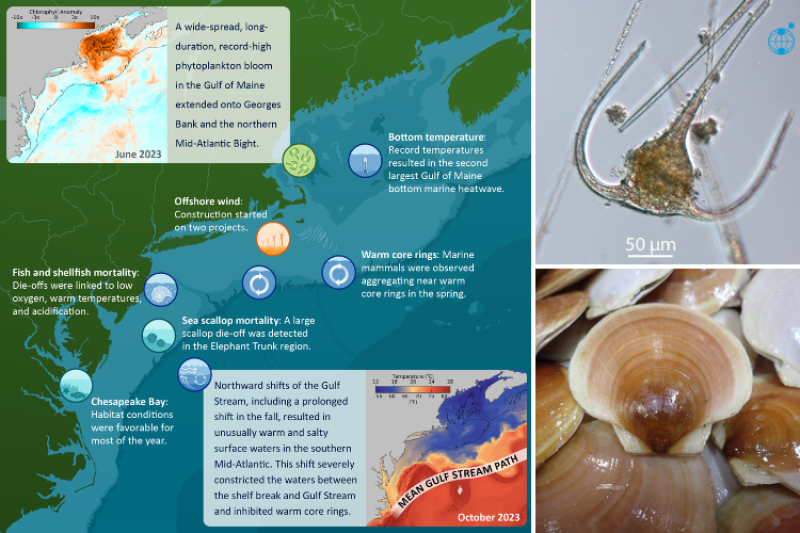NOAA’s Northeast Integrated Ecosystem Assessment team released their annual Mid-Atlantic and New England State of the Ecosystem Reports. These reports synthesize the ecological, oceanographic, and socioeconomic aspects of the Georges Bank, Gulf of Maine, and Mid-Atlantic Bight ecosystems as they relate to fishery management objectives. Two notable events highlighted in the reports were the Gulf of Maine phytoplankton bloom in summer 2023 and a large dieoff of sea scallops in the Elephant Trunk area of the Mid-Atlantic region.
We presented results from the Mid-Atlantic report to the Mid-Atlantic Fishery Management Council in mid-April. We will present the New England report to the New England Fishery Management Council in June. Annual presentations and discussions with the councils are part of our effort to effectively deliver ecosystem science to decision makers and solicit feedback for future reports. We will share a summary of both State of the Ecosystem reports through a OneNOAA seminar on Thursday, May 30 at 1pm ET.
Gulf of Maine Phytoplankton Bloom Intrigues Scientists
One notable event from 2023 was the widespread, record-breaking phytoplankton bloom in the Gulf of Maine that lasted from March until August. T bloom was dominated by the dinoflagellate species Tripos muelleri. Satellite images detected chlorophyll a concentrations up to 10 times greater than the long-term average. This was the highest concentration of chlorophyll a in this region since ocean color satellite records began in 1997.
Dr. Kimberly Hyde is an Operations Research Analyst and phytoplankton ecology expert at the Northeast Fisheries Science Center. She is proud of the quick, multi-institution research effort that sprang into action when the bloom was first reported. “The rapid response and sharing of observations helped us gain better insight to this anomalous event. Folks from NOAA, University of New Hampshire, University of Maine, Woods Hole Oceanographic Institute, Northeast Regional Association of Coastal Ocean Observing systems, and other academic and research institutions, shared observations and data to try and understand the impacts of this bloom on the ecosystem and nearby coastal communities.”
Harpoon fishermen that need clear water to see the fish were not able to fish for much of the season due to the brown, murky waters produced by high phytoplankton densities.
“I don’t think the impact of the bloom on the coastal communities is talked about enough.”
Researchers are actively trying to identify specific environmental factors that created such a strong, persistent bloom. They are also unsure of the fate of the phytoplankton bloom and the potential impacts to the food web and fisheries. There was no evidence that the T. muelleri were consumed by planktivores—organisms that feed only on phytoplankton. Nor was there evidence of phytoplankton in sediment traps—devices used to identify sources and amount of carbon is sinking to the bottom of the ocean. Scientists continue to investigate the impacts that this major phytoplankton bloom has had and will have on the Gulf of Maine ecosystem.
Using Yesterday’s Data to Understand Today’s Problems
Another notable event listed in the reports was a large dieoff of sea scallops in the Elephant Trunk area of the Mid-Atlantic region. Dvora Hart is an Operations Research Analyst at the Northeast Fisheries Science Center. Her team of scallop experts in NOAA’s Atlantic Sea Scallop Research Track Assessment Working Group have been working to better understand the relationships between recent environmental trends and scallop dieoffs along the Northeast shelf. They examine recent and historical environmental conditions described in the State of the Ecosystem reports. Bottom temperatures in Elephant Trunk exceeded 17 oC (62.6 oF) for 30 days in late 2022. This resulted in a long period of stressful temperatures for adult sea scallops in this area, likely driving the 2022–2023 sea scallop dieoff. Other environmental stressors that can contribute to changes in sea scallop populations include ocean acidification and low oxygen concentrations.
Integrated Ecosystem Assessments and long-term monitoring of environmental indicators are valuable for our understanding of events like these. The communication of the drivers to decision makers helps to create climate-ready fisheries. Warming trends, such as those observed in Elephant Trunk, are expected to continue. The continued collaboration between our scientists, partners, and regional fishery management councils helps to ensure that ecosystem-wide impacts of these changes are being effectively communicated to decision-making partners.
Collaboration with Councils Increases Effective Science Communication
The Integrated Ecosystem Assessment program has established a framework for scientists to deliver ecosystem-science into the hands of decision makers. A large component of this framework is production of products with local fisheries councils, or other resource management groups. Three regions produce annual reports that describe changes and trends in their ecosystems and present these findings to their regional fishery management councils: Alaska, California Current, and the Northeast.
Since 2018, we have presented the State of the Ecosystem reports to the New England and Mid-Atlantic Fishery Management Councils and solicited feedback from them to improve ecosystem-science communication. As a result, this year’s reports feature a new format for the “Risks to Meeting Fishery Objectives” section and a “2023 Highlights” graphic that depicts notable ecosystem events up and down the Northeast coast from the previous year. This graphic is both visually engaging, and easily and quickly communicates events that may affect the meeting of fisheries objectives within the ecosystems. These events are highlighted in the graphical summary and explained in more detail at the end of the reports.




